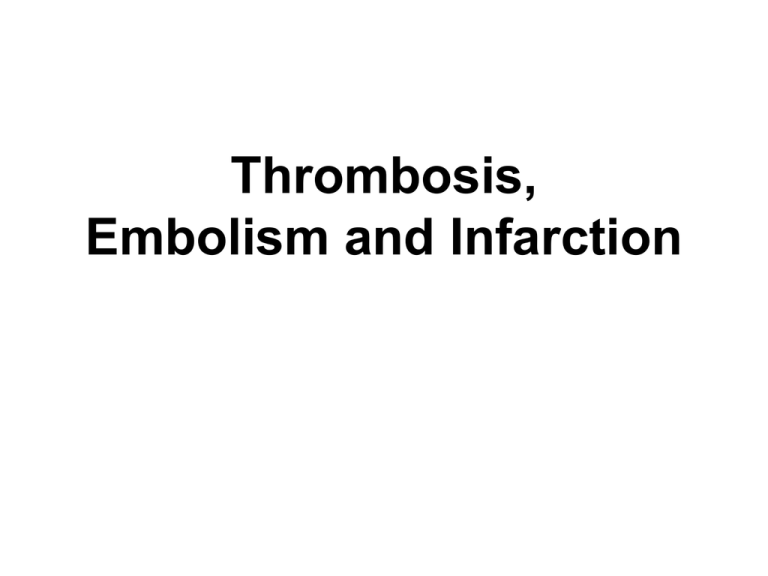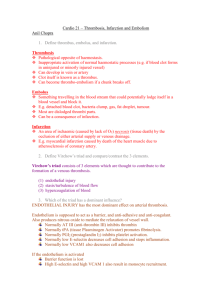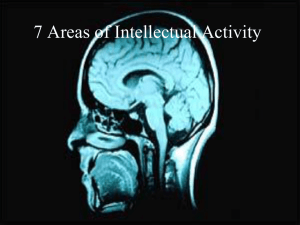
Thrombosis,
Embolism and Infarction
THROMBOSIS
Thrombus formation (called Virchow's triad):
(1) endothelial injury,
(2) stasis or turbulent blood flow
(3) hypercoagulability of the blood
Endothelial Injury
Endothelial injury is particularly important for thrombus formation
in the heart or the arterial circulation, where the normally high flow
rates might otherwise impede clotting by preventing platelet
adhesion and washing out activated coagulation factors.
Thus, thrombus formation within cardiac chambers (e.g., after
endocardial injury due to myocardial infarction), over ulcerated
plaques in atherosclerotic arteries, or at sites of traumatic or
inflammatory vascular injury (vasculitis) is largely a consequence
of endothelial cell injury.
From: Prospects for Cardiovascular Research
JAMA. 2001;285(5):581-587. doi:10.1001/jama.285.5.581
Figure Legend:
Chronic endothelial injury, inflammation, and oxidative stress arecentral to the development of atherosclerosis. Endothelial injury
resultsfrom a variety of factors including tobacco use, hypercholesterolemia, interventionaltherapies with angioplasty or coronary
stents, and from ulceration or fissuringof atherosclerotic plaques. At sites of endothelial injury, production ofendothelial-derived
substances (nitric oxide [NO], tissue plasminogen activator[tPA], and prostacyclin [PGI2]) is decreased, creating a
prothromboticenvironment characterized by increased
platelet
and
leukocyte
adhesion, increasedpermeability to plasma
Copyright
© 2012
American
Medical
Date
of download:
3/11/2013
lipoproteins,
myointimal
hyperplasia, and vasoconstriction.Ulceration
or
fissuring
Association. All rights reserved. of the atherosclerotic plaque results from
degradationof collagen matrix in the fibrous cap by metalloproteases released from macrophages.Exposure of the subendothelium
after plaque ulceration or fissuring leadsto platelet adhesion and aggregation and local accumulation of largely plateletderivedmediators (thromboxane A2, serotonin, adenosine diphosphate [ADP],thrombin, platelet activating factor [PAF], oxygenderived free radicals,tissue factor, and endothelin) that promote thrombus growth, fibroproliferation,and vasoconstriction. LDL
indicates low-density lipoprotein.
Endothelial Injury
Physical loss of endothelium can lead to exposure of the
subendothelial ECM, adhesion of platelets, release of tissue
factor, and local depletion of PGI2 and plasminogen activators.
However, it should be emphasized that endothelium need not be
denuded or physically disrupted to contribute to the development
of thrombosis; any perturbation in the dynamic balance of the
prothombotic and antithrombotic activities of endothelium can
influence local clotting events.
Thus, dysfunctional endothelial cells can produce more
procoagulant factors (e.g., platelet adhesion molecules, tissue
factor, PAIs) or may synthesize less anticoagulant effectors (e.g.,
thrombomodulin, PGI2, t-PA).
Endothelial dysfunction can be induced by a wide variety of
insults, including hypertension, turbulent blood flow, bacterial
endotoxins, radiation injury, metabolic abnormalities such as
hypercholesterolemia.
Alterations in Normal Blood Flow
Turbulence contributes to arterial and cardiac thrombosis by
causing endothelial injury or dysfunction, as well as by forming
countercurrents and local pockets of stasis; stasis is a major
contributor in the development of venous thrombi.
Normal blood flow is laminar such that the platelets (and other
blood cellular elements) flow centrally in the vessel lumen,
separated from endothelium by a slower moving layer of plasma.
Stasis and turbulence therefore:
http://www.oocities.org/venkatej/mech/fluid_mechanics/LaminarFlowProfile.gif
http://www.phlebolymphology.org/2009/07/recent-findings-in-the-pathogenesis-of-venous-wall-degradation/
http://content.onlinejacc.org/data/Journals/JAC/23086/02059_gr4.jpeg
Alterations in Normal Blood Flow
Promote endothelial activation,
enhancing procoagulant activity and
leukocyte adhesion. In part through
flow-induced changes in endothelial
cell gene expression.
Disrupt laminar flow and bring platelets
into contact with the endothelium.
Prevent washout and dilution of
activated clotting factors by fresh
flowing blood and the inflow of clotting
factor inhibitors.
Turbulence and stasis contribute to
thrombosis
Ulcerated atherosclerotic plaques cause turbulence.
Aortic and arterial dilations called aneurysms result in local stasis and are
therefore fertile sites for thrombosis.
Acute myocardial infarctions result in areas of noncontractile myocardium
and sometimes cardiac aneurysms; both are associated with stasis and flow
abnormalities.
Hyperviscosity (such as is seen with polycythemia vera) increases resistance
to flow and causes small vessel stasis; the deformed red cells in sickle cell
anemia ( Chapter 14) cause vascular occlusions, with the resulting stasis
also predisposing to thrombosis.
How John C. Lincoln's advanced deep vein thrombosis
treatment works: Once guided to the blood clot, an AngioJet
catheter creates a powerful fluid flow, drawing the clot toward the
inflow windows. Inside the catheter, saline jets break the clot into
microscopic particles, which are removed from the body.
http://www.doctortipster.com/wp-content/uploads/2011/08/Deepvenous-thrombosis-causes.jpg
http://www.stoptheclot.org/images/natt_other_ar
t/acute%20left%20leg%20DVT;%20postthormb
otic%20syndrome%20right%20leg.jpg
http://www.aafp.org/afp/2012/1115/afp20121115p913-f1.gif
Hypercoagulability
http://ars.els-cdn.com/content/image/1-s2.0-S0268960X08000362-gr1.jpg
PRIMARY (GENETIC)
Common
• Factor V mutation (G1691A mutation; factor V Leiden)
• Prothrombin mutation (G20210A variant) 5,10Methylenetetrahydrofolate reductase (homozygous C677T
mutation)
• Increased levels of factors VIII, IX, XI, or fibrinogen.
Factor V mutation (G1691A mutation; factor V Leiden)
http://www.med.illinois.edu/hematology/Pics,%20etc/Factor%20V%20Leiden%20Main.JPG
In the normal person, factor V functions as a cofactor to allow factor Xa to
activate thrombin. Thrombin in turn cleaves fibrinogen to form fibrin. Activated
protein C (aPC) is a natural anticoagulant that acts to limit the extent of clotting
by cleaving and degrading factor V. (http://en.wikipedia.org/wiki/Factor_V_Leiden)
http://www.ismaap.org/uploads/pics/faktor1_eng.jpg
Hypercoagulability
Rare
Antithrombin III deficiency
Protein C deficiency
Protein S deficiency
Very Rare
Fibrinolysis defects
Homozygous homocystinuria (deficiency of
cystathione β-synthetase)
http://www.practical-haemostasis.com/images/Images-2/Thrombophilia%20Tests/pc_ps_pathway.jpg
http://www.med4you.at/laborbefunde/lbef2/atIII_anim3.gif
Thrombomodulin (TM)
CD141 or BDCA-3 is an integral membrane protein
expressed on the surface of endothelial cells and serves
as a cofactor for thrombin. It reduces blood coagulation
by converting thrombin to an anticoagulant enzyme from
a procoagulant enzyme.
http://en.wikipedia.org/wiki/Thrombomodulin
http://www.neurology.org/content/78/3/157/F1.large.jpg
APC= activated Protein C
Fig. 1: Activated protein C anticoagulant pathway: 1.
Bloomenthal D et al. CMAJ 2002;167:48-54
©2002 by Canadian Medical Association
Hypercoagulability (secondary)
High Risk for Thrombosis
Prolonged bedrest or immobilization
Myocardial infarction
Atrial fibrillation
Tissue injury (surgery, fracture, burn)
Cancer
Prosthetic cardiac valves
Disseminated intravascular coagulation
Heparin-induced thrombocytopenia
Antiphospholipid antibody syndrome
Hypercoagulability (secondary)
Lower Risk for Thrombosis
Hyperestrogenic states (pregnancy and postpartum)
Oral contraceptive use
Cardiomyopathy
Nephrotic syndrome
Sickle cell anemia
Smoking
http://hcp.obgyn.net/image/image_gallery?img_id=2082561&t=1339545353297
Among the acquired thrombophilic states, two that are
particularly important.
Heparin-induced thrombocytopenia (HIT) syndrome.
Antiphospholipid antibody syndrome
(previously called the lupus anticoagulant
syndrome).
Heparin-induced thrombocytopenia (HIT) syndrome
HIT occurs following the administration of unfractionated
heparin, which may induce the appearance of antibodies
that recognize complexes of heparin and platelet factor 4
on the surface of platelets, as well as complexes of heparinlike molecules and platelet factor 4-like proteins on
endothelial cells.
Binding of these antibodies to platelets results in their
activation, aggregation, and consumption (hence the
thrombocytopenia in the syndrome name).
Effect on platelets and endothelial damage combine to
produce a prothrombotic state, even in the face of heparin
administration and low platelet counts.
Newer low-molecular weight heparin preparations induce
antibody formation less frequently, but still cause thrombosis
if antibodies have already formed. Other anticoagulants such
as fondaparinux (a pentasaccharide inhibitor of factor X) also
cause a HIT-like syndrome on rare occasions.
Antiphospholipid antibody syndrome
Antiphospholipid antibodies are a heterogeneous group of
auto-antibodies (IgG, IgM, and IgA)
This syndrome has protean clinical manifestations, including
recurrent thromboses, repeated miscarriages, cardiac valve
vegetations, and thrombocytopenia.
Depending on the vascular bed involved, the clinical
presentations can include pulmonary embolism (following
lower extremity venous thrombosis), pulmonary hypertension
(from recurrent subclinical pulmonary emboli), stroke, bowel
infarction, or renovascular hypertension.
Fetal loss is attributable to antibody-mediated inhibition of tPA activity necessary for trophoblastic invasion of the uterus.
Antiphospholipid antibody syndrome is also a cause of renal
microangiopathy, resulting in renal failure associated with
multiple capillary and arterial thromboses.
http://www.acponline.org/graphics/bioterro/canthrax/anti_lipid.jpg
Figure 3 Endothelial cell activation by anti-β2GPI autoantibodies
Meroni, P. L. et al. (2011) Pathogenesis of antiphospholipid syndrome: understanding the antibodies
Nat. Rev. Rheumatol. doi:10/1038/nrrheum.2011.52
beta2 Glycoprotein 1
http://www.nature.com/nrrheum/journal/v7/n6/images/nrrheum.2011.52-f1.jpg
Thrombi can develop anywhere in the cardiovascular
system (e.g., in cardiac chambers, on valves, or in arteries,
veins, or capillaries).
The size and shape of thrombi depend on the site of origin
and the cause.
Arterial or cardiac thrombi usually begin at sites of
turbulence or endothelial injury.
Venous thrombi characteristically occur at sites of stasis.
Thrombi are focally attached to the underlying vascular
surface; arterial thrombi tend to grow retrograde from
the point of attachment, while venous thrombi extend in
the direction of blood flow (thus both propagate toward
the heart).
The propagating portion of a thrombus is often poorly
attached and therefore prone to fragmentation and
embolization.
Arterial vs venous thrombi
• Grow retrograde to
flow
• Begin at site of injury
or turbulence
• Frequently occlusive
• Occur in coronary,
cerebral, femoral
arteries
• Grow with direction of
flow
• Begin at site of stasis
• Occlusive
• Occur in lower
extremities 90%, also
upper extremities,
periprostatic plexus,
ovarian or periuterine
veins
Thrombi often have grossly and microscopically
apparent laminations called lines of Zahn; these
represent pale platelet and fibrin deposits alternating
with darker red cell–rich layers.
Such laminations signify that a thrombus has formed in
flowing blood; their presence can therefore distinguish
antemortem thrombosis from the bland nonlaminated
clots that occur postmortem
http://i48.tinypic.com/2vmvqcj.jpg
http://811699.net/wp-content/uploads/2011/03/LUNG065.jpg
Fate of the Thrombus
• Propagation. Thrombi accumulate additional platelets and fibrin.
• Embolization. Thrombi dislodge and travel to other sites in the
vasculature.
• Dissolution. Result of fibrinolysis, which can lead to the rapid
shrinkage and total disappearance of recent thrombi. (Extensive fibrin
deposition and crosslinking in older thrombi renders them more
resistant to lysis.) Natural and Therapeutic.
• Organization and recanalization. Older thrombi become organized
by the ingrowth of endothelial cells, smooth muscle cells, and
fibroblasts. Capillary channels eventually form that re-establish the
continuity of the original lumen, albeit to a variable degree.
Organized arterial thrombus
http://www.geocities.ws/m4pathology/Osce/Slides/histsch03.jpg
Recanilizatuion
http://farm3.static.flickr.com/2791/4337748744_3a92ba6583.jpg
Aortic thrombi from electrical injury
Lung hilum thromboembolus with lines
of Zahn
Right atrial mural thrombus with lines
of Zahn
Clinical Consequences.
Thrombi are significant because they cause obstruction
of arteries and veins, and are sources of emboli.
Which effect predominates depends on the site of the
thrombosis.
Venous thrombi can cause congestion and edema in
vascular beds distal to an obstruction, but they are far
more worrisome for their capacity to embolize to the
lungs and cause death (see below).
Conversely, although arterial thrombi can embolize and
cause downstream infarctions, a thrombotic occlusion at
a critical site (e.g., a coronary artery) can have more
serious clinical consequences.
Embolisms
• Detached intravasular solid, liquid, gasous mass
carried by the blood
• Pulmonary embolisms
Often arise from deep vein thromboses
• Associated with immobilization, hypercoagulability
Frequently small, silent, becoming organized
Right heart failure, cor pulmonale, when >60%
pulmonary circulation obstructed
Rupture of obstructed arteries causes bleeding
without infarction due to blood supply
Multiple emboli lead to hypertension and right
ventricular failure
An embolus is a detached intravascular solid, liquid, or
gaseous mass that is carried by the blood to a site
distant from its point of origin.
The term embolus was coined by Rudolf Virchow in 1848 to
describe objects that lodge in blood vessels and obstruct the flow
of blood. Almost all emboli represent some part of a dislodged
thrombus, hence the term thromboembolism. Rare forms of
emboli include fat droplets, nitrogen bubbles, atherosclerotic
debris (cholesterol emboli), tumor fragments, bone marrow, or
even foreign bodies. However, unless otherwise specified,
emboli should be considered thrombotic in origin. Inevitably,
emboli lodge in vessels too small to permit further passage,
causing partial or complete vascular occlusion; a major
consequence is ischemic necrosis (infarction) of the downstream
tissue. Depending on where they originate, emboli can lodge
anywhere in the vascular tree; the clinical outcomes are best
understood based on whether emboli lodge in the pulmonary or
systemic circulations.
http://www.news.vcu.edu/images/image.aspx?id=2904&w=400
Systemic thromboembolism
• Emboli in arterial circulation
• Arise from intracardiac mural thrombi
60% associated with left ventricular wall
infarcts
25% associated with atrial dilation or
fibrillation
Remainder originate from aneurysms, valvular
vegetation
• Deposit in lower extremities or brain
• Consequences depend on caliber of
occluded vessel, redundant blood supply
http://images.radiopaedia.org/images/540186/4ee4c494df07ac6c3ecd9b2c622c75.jpg
An infarct is an area of ischemic necrosis caused by occlusion
of either the arterial supply or the venous drainage.
Tissue infarction is a common and extremely important cause of
clinical illness.
Roughly 40% of all deaths in the United States are caused by
cardiovascular disease, and most of these are attributable to
myocardial or cerebral infarction.
Pulmonary infarction is also a common complication in many clinical
settings, bowel infarction is frequently fatal, and ischemic necrosis
of the extremities (gangrene) is a serious problem in the diabetic
population.
Nearly all infarcts result from thrombotic or embolic arterial
occlusions.
Occasionally infarctions are caused by other mechanisms,
including local vasospasm, hemorrhage into an atheromatous
plaque, or extrinsic vessel compression (e.g., by tumor).
Rarer causes include torsion of a vessel (e.g., in testicular
torsion or bowel volvulus), traumatic rupture, or vascular
compromise by edema (e.g., anterior compartment syndrome)
or by entrapment in a hernia sac.
Although venous thrombosis can cause infarction, the more
common outcome is just congestion; in this setting, bypass
channels rapidly open and permit vascular outflow, which then
improves arterial inflow. Infarcts caused by venous thrombosis
are thus more likely in organs with a single efferent vein (e.g.,
testis and ovary).
White infarcts occur with arterial occlusions in solid organs
with end-arterial circulation (e.g., heart, spleen, and kidney),
and where tissue density limits the seepage of blood from
adjoining capillary beds into the necrotic area.
Red infarcts occur
(1) with venous occlusions (e.g., ovary)
(2) in loose tissues (e.g., lung) where blood can collect in the
infarcted zone,
(3) in tissues with dual circulations (e.g., lung and small
intestine) that allow blood flow from an unobstructed
parallel supply into a necrotic zone,
(4) in tissues previously congested by sluggish venous
outflow
(5) when flow is re-established to a site of previous arterial
occlusion and necrosis (e.g., following angioplasty of an
arterial obstruction).
Factors That Influence Development of an Infarct.
The effects of vascular occlusion can range from no
or minimal effect to causing the death of a tissue or
person.
The major determinants of the eventual outcome are:
(1) the nature of the vascular supply,
(2) the rate at which an occlusion develops,
(3) vulnerability to hypoxia,
(4) the oxygen content of the blood.
Neurons: 3 – 4 minutes
Myocardial cells: 20 – 30 minutes
Fibroblasts, skeletal muscle: hours
Nature of the vascular supply. The availability of an alternative
blood supply is the most important determinant of whether vessel
occlusion will cause damage.
Rate of occlusion development. Slowly developing occlusions are
less likely to cause infarction, because they provide time to develop
alternate perfusion pathways.
Vulnerability to hypoxia. Neurons undergo irreversible damage
when deprived of their blood supply for only 3 to 4 minutes.
Myocardial cells, though hardier than neurons, are also quite
sensitive and die after only 20 to 30 minutes of ischemia. In contrast,
fibroblasts within myocardium remain viable even after many hours
of ischemia
Oxygen content of blood. A partial obstruction of a small vessel
that would be without effect in an otherwise normal individual might
cause infarction in an anemic or cyanotic patient.
The dominant histologic characteristic of infarction is ischemic
coagulative necrosis.
It is important to recall that if the vascular occlusion has occurred
shortly (minutes to hours) before the death of the person, no
demonstrable histologic changes may be evident; it takes 4 to 12
hours for the tissue to show frank necrosis. Acute inflammation is
present along the margins of infarcts within a few hours and is
usually well defined within 1 to 2 days.
Most infarcts are ultimately replaced by scar. The brain is an
exception to these generalizations, as central nervous system
infarction results in liquefactive necrosis.
DISSEMINATED INTRAVASCULAR COAGULATION (DIC)
Disorders ranging from obstetric complications to advanced
malignancy can be complicated by DIC, the sudden or insidious onset
of widespread fibrin thrombi in the microcirculation.
Although these thrombi are not grossly visible, they are readily
apparent microscopically and can cause diffuse circulatory
insufficiency, particularly in the brain, lungs, heart, and kidneys.
To complicate matters, the widespread microvascular thrombosis
results in platelet and coagulation protein consumption (hence the
synonym consumption coagulopathy), and at the same time,
fibrinolytic mechanisms are activated.
Thus, an initially thrombotic disorder can evolve into a bleeding
catastrophe. It should be emphasized that DIC is not a primary
disease but rather a potential complication of any condition associated
with widespread activation of thrombin.
http://medicalpicturesinfo.com/wp-content/uploads/2011/12/Disseminated-Intravascular-Coagulation.jpg
http://upload.wikimedia.org/wikipedia/commons/thumb/0/0b/Acute_thrombotic_microangiopathy__pas_-_very_high_mag.jpg/230px-Acute_thrombotic_microangiopathy_-_pas_-_very_high_mag.jpg
https://www.meducation.net/encyclopedia/29623
Extra Stuff
Fat and marrow embolism
• Release of fatty marrow from broken
bones
• Onset of symptoms 1 – 3 days after injury
• Leads to pulmonary insufficiency
Tachypnea, dyspnea, tachycardia
• Neurological symptoms
Irritability, restlessness
• Thrombocytopenia
Platelets adhere to fat globules
Diffuse petechial rash
Fat and marrow embolism
• Mechanical obstruction
Fat emboli with RBC and platelet aggregates
occlude pulmonary and cerebral
microvasculature
• Biochemical injury
FFA released from fat globules injure
endothelium initiating inflammation
Platelet aggregation and granulocyte
recruitment result in free radicals, proteases,
eicosanoids
Fat embolism
Air embolisms
• Iatrogenic consequences of
Coronary bypass surgery
Neurosurgery
Laparoscopic procedures
• Chest wall injury
• Decompression sickness
Nitrogen bubbles from blood within muscle,
lungs, joints
Edema or ischemic necrosis in lungs
(emphysema), femoral head, tibia, humerus
Amniotic fluid embolism
• Infusion of amniotic fluid containing fetal
components into uterine veins via rupture
• Incidence 1:40K; mortality 80%; morbidity 13%
total incidence, 85% survivors
• Pulmonary microcirculation may contain
Fetal cells, vernix caseosa fat, fetal respiratory or GI
mucin, lanugo hair
• Onset characterized by sudden, severe
dyspnea, cyanosis, shock, headache, seizures
• Followed by pulmonary edema
• Diffuse Intravascular Coagulation (DIC)







